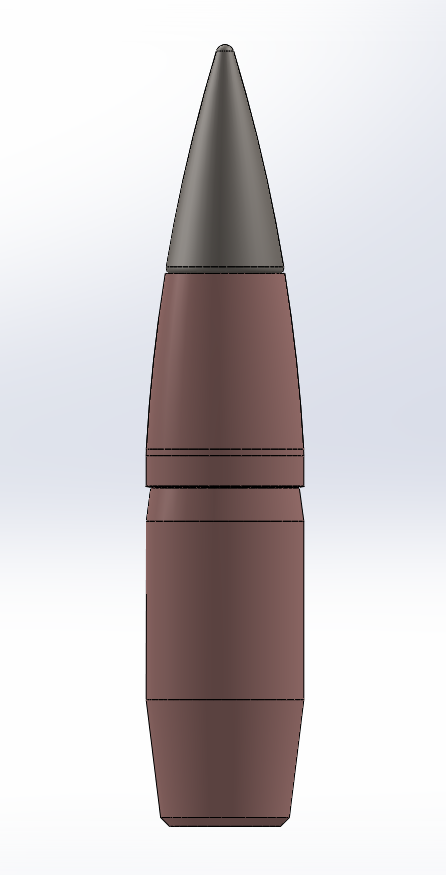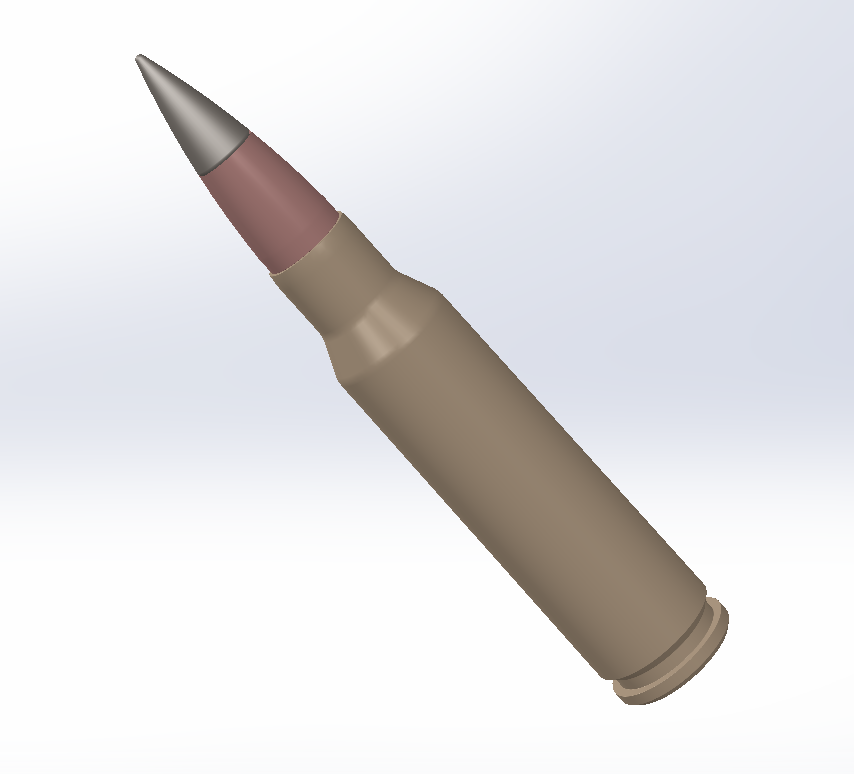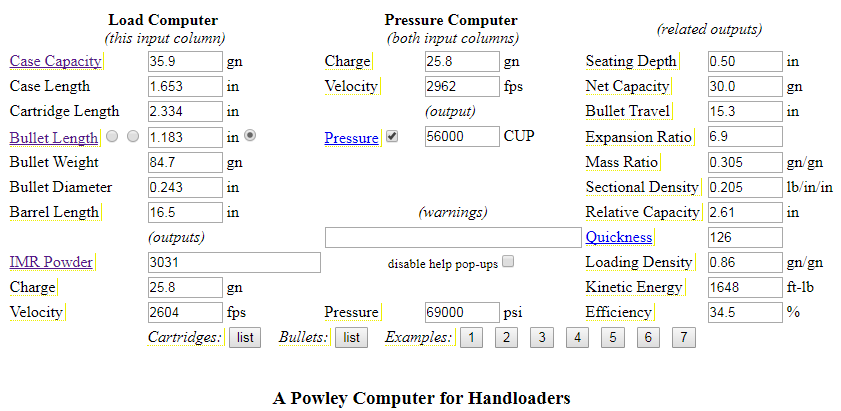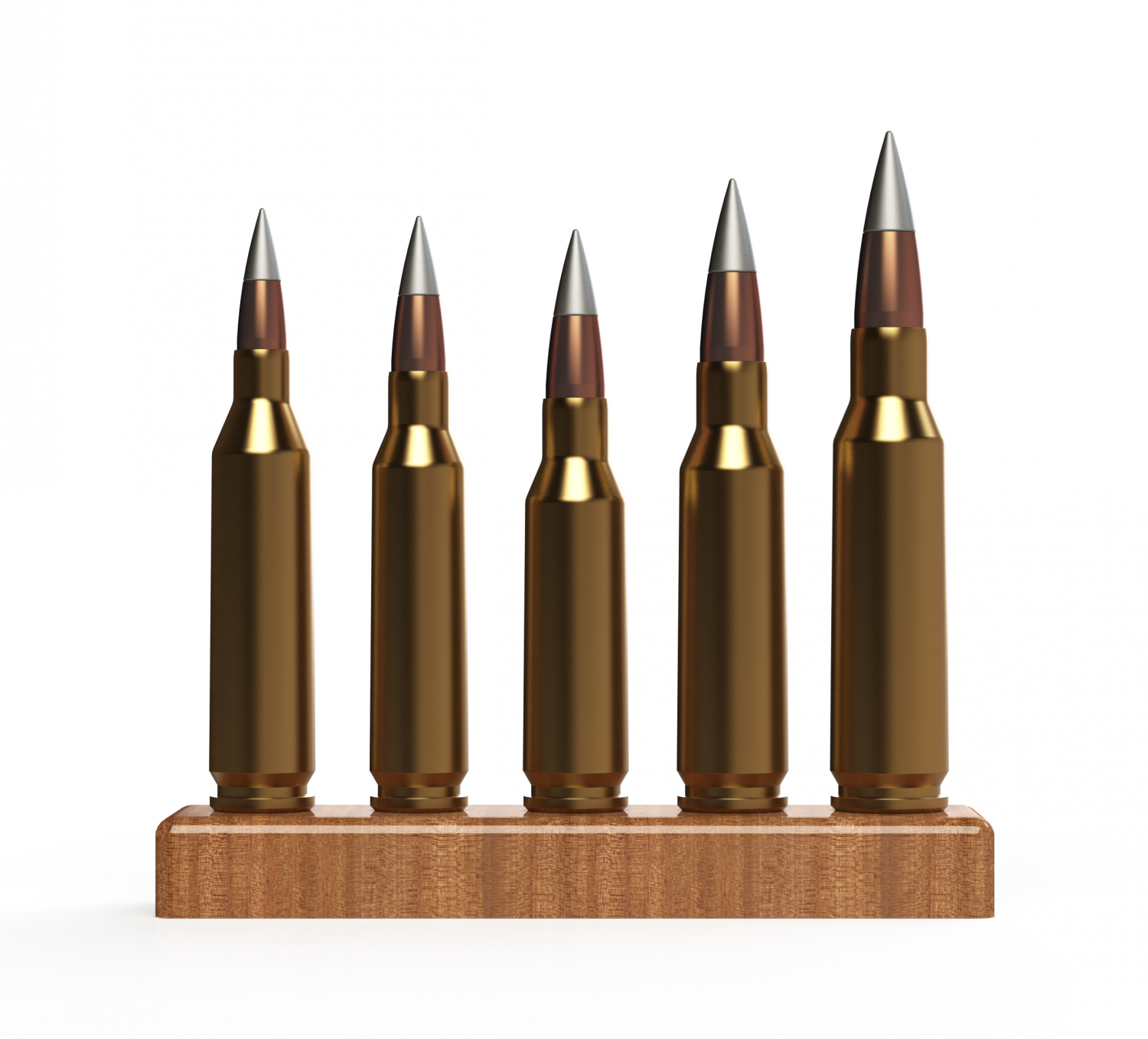If you were designing the next small arms round, how would you do it? What methods would you use to determine its physical characteristics and performance attributes? How would you know what was too large or too small, too powerful or too weak? Perhaps more critically, how do different methods for answering these questions compare to one another? Could some methods be better or worse than others?
In this article, we will make our way down this rabbit hole. Our journey will take us through the design of two different rounds of small arms ammunition: one created by an organic method based on selecting the most desirable characteristics, and another created through a systematic process which determines characteristics procedurally. I call these two methods preference-driven and process-driven design.
Preference-Driven Design
Design that is accomplished via the selection and amalgamation of subjectively preferred characteristics from other previous works.
Process-Driven Design
Design that is accomplished through the construction of a process structure which when fed the required data indicates a solution.
For our examples, let us consider two hypothetical nations both looking to construct a new small arms ammunition paradigm. These two nations have very different cultures, and therefore approach the problem differently. The Romulans are a proud warrior nation, inspired by great deeds to act quickly and decisively. Their scientists and engineers use preference-driven design to create new war materiel for their armies. In contrast, the Vulcans are a cogitating nation, who admire great thoughts and science above all else. Their scientists and engineers consider process-driven design the only method capable of creating the most optimum instruments for waging war.
PREFERENCE-DRIVEN DESIGN: THE ROMULAN EFFORT
The Romulan engineer is given the problem of designing a new round for combat out to 600 meters, and immediately begins brainstorming its final characteristics. He is familiar with all of the previous successful small arms ammunition and he knows that the new round must be light enough to carry in quantity, but it must also be powerful to properly dispatch the enemies of the Romulan nation. After considering previous efforts, he determines that the ideal projectile will be 125 grains in weight and 0.277 inches in diameter. He reasons that there are no projectiles of such a mass that are considered inadequate for killing a man, and the 6.8mm (.0.277″) diameter has been determined to be the smallest acceptable size in several previous studies. Noting that low drag projectiles with hard armor piercing cores and fragmenting jackets give better performance than projectiles of other varieties, the Romulan engineer chooses these characteristics to incorporate into his design. He designs a projectile that conforms to these specifications, resulting in a 125gr .277″ caliber three-piece fragmenting armor piercing low drag projectile:
He knows that any new round must also have a good trajectory and relatively high muzzle velocity to be effective and to allow the Romulan soldier to easily make hits at medium range. However, he also knows that a round that is too powerful will actually be counter-productive as it will prevent the soldier from making hits as quickly as possible. Therefore, the Romulan engineer chooses a medium velocity of 2,750 ft/s, high enough for a good trajectory (especially with the low drag bullet), but low enough to moderate recoil.
The engineer’s work is nearly done. All he needs to do now is determine the size of case needed to propel the chosen bullet at the determined velocity. This is quickly determined by computer calculation, and verified in tests:
The resulting round, which he calls the 6.86x46mm Romulan, is completed and passes into the next phase for final modifications and production engineering prior to adoption by the Romulan Army:
PROCESS-DRIVEN DESIGN: THE VULCAN EFFORT
Meanwhile, a Vulcan engineer has also been tasked with designing a 600 meter small arms round. Like the Romulan engineer, the Vulcan has read all of the same papers and knows in equal detail the history of all the same historical small arms ammunition programs. Unlike his Romulan counterpart, however, he does not immediately begin thinking about what the final round will look like. As a logical Vulcan he feels that one of his prime duties is to avoid allowing his own biases to influence the project. Therefore, the Vulcan begins by thinking about what he has been tasked with and how he could develop a process which would give him the best results with the least interference from his own bias. After some thought, he writes down the following seven-step process in his design notes:
How do we create a process to follow for designing ammunition?
- Explicate requirements/create criteria – what do we really need to do?
- Select candidate projectile(s).
- Scale projectiles to several candidate calibers.
- Derive minimum velocities to meet each criterion for each caliber.
- Add +250 ft/s to criterion that requires the highest velocity, for each caliber.
- Model cases which satisfy velocity requirements at given pressure, etc.
- Down-select to final round and caliber based on weight and other disqualifying factors.”
According to this process, the Vulcan engineer’s first step is to create a set of criteria for a 600 meter round, which will help him answer the question “what does a 600 meter round actually need to be capable of?” He knows that at this range, it’s not enough for a projectile to simply hit a target, it needs to be able to kill even through barriers, have a good trajectory, and possess good close-range lethality characteristics. In his notes, he jots down some more detailed requirements:
Baseline Requirements:
– Penetrate 3.5mm mild steel plate at 600m and cause lethal wound
– Good lethality (fragmentation, multiple wound tracks) out to 400m
– Point-blank range no less than 300 meters (no more than 5 inch drop at 300 meters)
– Drop at 600 meters no greater than 100 inches with MPBR zero
– Windage at 600 meters no greater than 50 inches with MPBR zero and 10 mph crosswind
Like the Romulan engineer, the Vulcan engineer recognizes the potential of modern low drag three-piece fragmenting projectiles. For step 2, he therefore selects the same shape and design of bullet as the one used by the Romulan engineer. Using computer aided drafting software, he is able to scale this design to five different calibers, recording their relevant characteristics in his notes:
3. Scale projectiles to candidate calibers.
.204
Total Mass: 3.25 g
Jacket Mass: 0.83 g
Slug Mass: 1.47 g
G7 BC: 0.192
.224
Total Mass: 4.30 g
Jacket Mass: 1.10 g
Slug Mass: 1.95 g
G7 BC: 0.211
.243
Total Mass: 5.49 g
Jacket Mass: 1.40 g
Slug Mass: 2.49 g
G7 BC: 0.229
.264
Total Mass: 7.03 g
Jacket Mass: 1.80 g
Slug Mass: 3.19 g
G7 BC: 0.248
.284
Total Mass: 8.76 g
Jacket Mass: 2.24 g
Slug Mass: 3.97 g
G7 BC: 0.267
With the projectiles in each caliber designed, the Vulcan engineer develops simple formulas to help him determine the muzzle velocities each caliber needs to meet the requirements:
Penetration ~ 200 J * ([bullet diameter in inches] / 0.229)^1.5 + [projectile mass in kilograms] * (80 J / ([slug mass in kilograms]))
Lethality ~ 50 J + [projectile mass in kilograms] * (30 J / ([jacket mass in kilograms] / 6) + [projectile mass in kilograms] * (30 J / [slug mass in kilograms])
He finds that in order to meet the penetration requirement, the calibers need the following striking energies:
.204 – 346 J
.224 – 370 J
.243 – 395 J
.264 – 424 J
.284 – 453 J
The math for the lethality requirement reduces to a simple flat figure of 820 J for every caliber. However, the Vulcan engineer also knows that fragmentation will not occur without a certain striking velocity. His research indicates that a projectile of the chosen design must have a striking velocity of 1,900 ft/s or higher in order to fragment. This means that each projectile needs to have both at least 820 J striking energy and at least 1,900 ft/s striking velocity in order to exhibit the desired fragmentation.
Next, the Vulcan engineer uses a ballistic calculator to determine the minimum muzzle velocities needed to meet each requirement for each caliber:
.204
Penetration: 2,920 ft/s
Lethality (energy): 3,420 ft/s (3,670 ft/s adjusted)
Lethality (frag thresh): 2,880 ft/s
PBR: 2,700 ft/s
Drop: 2,780 ft/s
Drift: 2,780 ft/s
.224
Penetration: 2,570 ft/s
Lethality (energy): 2,940 ft/s (3,190 ft/s adjusted)
Lethality (frag thresh): 2,790 ft/s
PBR: 2,660 ft/s
Drop: 2,710 ft/s
Drift: 2,580 ft/s
.243
Penetration: 2,300 ft/s
Lethality (energy): 2,710 ft/s (2,960 ft/s adjusted)
Lethality (frag thresh): 2,710 ft/s
PBR: 2,630 ft/s
Drop: 2,650 ft/s
Drift: 2,400 ft/s
.264
Penetration: 2,070 ft/s
Lethality (energy): 2,640 ft/s (2,890 ft/s adjusted)
Lethality (frag thresh): 2,640 ft/s
PBR: 2,610 ft/s
Drop: 2,610 ft/s
Drift: 2,250 ft/s
.284
Penetration: 1,830 ft/s
Lethality (energy): 2,590 ft/s (2,840 ft/s adjusted)
Lethality (frag thresh): 2,590 ft/s
PBR: 2,590 ft/s
Drop: 2,570 ft/s
Drift: 2,130 ft/s
From these results, he takes the highest velocity for each caliber, and adds 250 ft/s. This gives him the velocity needed to give all required characteristics throughout the barrel’s life and in all climatic conditions:
Resultant velocities:
.204 – 3,670 ft/s (3,420 ft/s + 250 ft/s)
.224 – 3,190 ft/s (2,940 ft/s + 250 ft/s)
.243 – 2,960 ft/s (2,710 ft/s + 250 ft/s)
.264 – 2,890 ft/s (2,640 ft/s + 250 ft/s)
.284 – 2,840 ft/s (2,590 ft/s + 250 ft/s)
To make his final selection, the Vulcan engineer needs to model cartridge cases for each caliber that will provide the required performance at a given peak pressure in the pressure computer. This is done by iterating performance characteristics and case dimensions until the data for the case models and the pressure computer agree:
.204:
.224:
.243:
.264:
.284:
The Vulcan engineer then records some relevant characteristics in his notebook before making the final down-selection:
.204 Vulcan:
Case mass: 7.70 g
Propellant mass: 2.44 g
Projectile mass: 3.25 g
Primer mass: 0.25 g
Total mass: 13.64 g
Relative capacity: 4.56 in
.224 Vulcan:Case mass: 6.61 g
Propellant mass: 1.94 g
Projectile mass: 4.30 g
Primer mass: 0.25 g
Total mass: 13.10 g
Relative capacity: 2.99 in
.243 Vulcan:Case mass: 7.29 g
Propellant mass: 1.98 g
Projectile mass: 5.49 g
Primer mass: 0.25 g
Total mass: 15.01 g
Relative capacity: 2.61 in
.264 Vulcan:Case mass: 8.44 g
Propellant mass: 2.46 g
Projectile mass: 7.03 g
Primer mass: 0.25 g
Total mass: 18.18 g
Relative capacity: 2.73 in
.284 Vulcan:Case mass: 10.08 g
Propellant mass: 3.01 g
Projectile mass: 8.76 g
Primer mass: 0.25 g
Total mass: 22.10 g
Relative capacity: 2.90 in
Now, he knows everything he needs to make his final selection. The best round to meet the requirements is the one that is the lightest and smallest of the five, and the one that does not produce any negative characteristics that would impede its suitability as a military caliber, such as excessive barrel wear. Therefore, the Vulcan engineer’s choice is the .224, as it is the lightest without having an excessive relative capacity (over 3.5 in). The .243, .264, and .284 calibers all satisfy the requirements, but they are 15%, 39%, and 69% heavier than the .224. The .204 is comparable to the .224 in weight, but has a relative capacity of 4.56, far in excess of the target 3.5 in, which suggests it would produce excessive barrel wear characteristics.
The Vulcan engineer completes his report, recommending the .224 caliber and its performance characteristics for future exploration. He also notes in his report that if the .224 caliber is for some reason deemed unsuitable for adoption, that the next caliber up – .243 – can be investigated, and so on until a suitable round is reached.
CONCLUSION:
With these examples, we can get an idea of how the two design methods compare. While a more extensive discussion of the methodology of these examples and how the methods compare will follow tomorrow, we can already tell that the preference-driven method is much faster and simpler, but produces less well optimized results. The process-driven methodology is much more involved and takes more time, but it produces better optimization by offloading most of the decision making to a set of engineered processes. As part of this, the Vulcan engineer conducted what I call a “spectrum study“, which is an evaluation of multiple different calibers that all meet the same criteria. By taking each caliber and creating a solution to the problem, he was able to eliminate ones as being either excessively powerful or unsuitable for service in some way, until he reached the optimum according to his criteria. Perhaps most critically, the fact that the conductor of a spectrum study does not know what the final configuration will be helps remove bias from the decision-making process, allowing for a better optimized solution.
Although process-driven design is capable of making better decisions than the preference-driven method, it does have limitations. Most obviously, the optimization will only be as good as the processes that are created to provide it. If the criteria used to select the optimum are faulty, the “optimum” that results will not meet the need it was designed to fill. A round selected according to a process with no more stringent criteria than “penetrate a piece of paper at 10 meters” will likely not meet the needs of a military user, for instance. In this same way, process-driven design may not produce good results if the problem is insufficiently understood, as in that case a sound process may be difficult or impossible to create. More intuitive preference-based methods may in such cases produce better results by virtue of simply not being optimized for the wrong criteria. Also, if the criteria are so stringent and well understood that the possible solution space is extremely narrow, then a process-driven method may be a waste of time, as the correct answer is plainly obvious in that case.
Having said that, the benefits of process-driven design are obvious in these examples. The process-designed optimized “Vulcan” round ostensibly meets the same range goal as its preference-designed “Romulan” round, while being a full 31% lighter (.224 Vulcan is 13.1 grams vs. 19.1 grams for the 6.86mm Romulan), as well as 28% smaller. Since the two rounds are quite different, they cannot be compared in every single respect, but it is notable that in a couple of important respects the .224 Vulcan may actually perform better than the larger 6.86mm Romulan. The .224 Vulcan, for example, has 90-120 meters more range where striking velocity is above 1,900 ft/s, than the 6.86mm, implying a significantly longer fragmentation range. Also, due to its much higher muzzle velocity, the .224 Vulcan can be expected to perform better against body armor, and may exhibit adiabatic shear effects against Level III steel armor out to 120 m or more, where in comparison it is unlikely that the 6.86mm Romulan will exhibit these effects at any range.
Tomorrow, I will publish a “behind the curtain” review of these experiments, which will also include a more in-depth ballistic comparison between the two rounds, as well as further discussion of preference-driven and process-driven design. In the meantime, let us know in the comments section below what you think about these two examples, the methodology presented here, and the potential benefits of either preference-driven or process driven design!
 Your Privacy Choices
Your Privacy Choices














